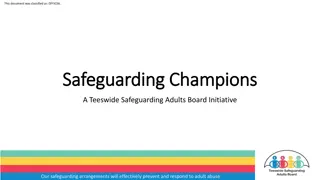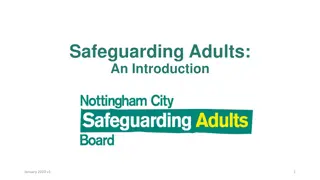Understanding Safeguarding Adults at Risk
Safeguarding adults at risk involves preventing, protecting, and promoting well-being to individuals aged 18 years or over who are experiencing or at risk of abuse or neglect. It emphasizes early intervention, recognizing signs of abuse, and respecting the individual's right to self-determination. Risk assessment is crucial as abuse, neglect, or exploitation can occur in various settings due to multiple factors.
Download Presentation

Please find below an Image/Link to download the presentation.
The content on the website is provided AS IS for your information and personal use only. It may not be sold, licensed, or shared on other websites without obtaining consent from the author. Download presentation by click this link. If you encounter any issues during the download, it is possible that the publisher has removed the file from their server.
E N D
Presentation Transcript
Definitions Key definitions about safeguarding adults at risk
Adult A person who is aged 18 or over
At risk At risk means that even if abuse, neglect or other kinds of harm have not actually occurred, they are likely to occur without support from services
Adult at risk Anyone aged 18 years or over who is experiencing, or is at risk of experiencing, abuse or neglect and has care and support needs (whether or not the local authority is meeting any of those needs) and as a result of those needs is unable to protect themselves against abuse or neglect or the risk of it
Important: Actual abuse or neglect does not need to occur before you intervene You should consider early support to safeguard an adult at risk to prevent actual abuse and neglect The abuse of adults at risk is often linked to their environment (for example, where they live, how much support they have) rather than their characteristics Risk of abuse or neglect may come from one concern or many different factors
Safeguarding adults at risk Safeguarding involves: preventing and protecting adults at risk from abuse or neglect educating people around them to recognise the signs and dangers of abuse and neglect promoting their well-being One important difference between safeguarding adults and safeguarding children is an adult s right to self-determination. Adults have the right to make their own choices and decide how to respond to the risk of abuse
Risk Includes abuse, neglect and/or exploitation May be linked to one specific incident or ongoing and/or repeated abuse and neglect May result from one issue or many differentfactors Can take place in a range of settings, such as a private dwelling, residential or day care
Neglect A failure to meet a person s basic physical, emotional, social or psychological needs, which is likely to have a negative effect on their well-being Neglect to an adult at risk includes a failure to access medical care or services, emotional neglect, letting them take inappropriate risks, not giving prescribed medication, not helping with personal hygiene or providing food, shelter or clothing Self-neglect lack of self-care to an extent that it threatens personal health and safety
Abuse Can be physical, sexual, psychological, emotional or financial (includes theft, fraud, pressure about money, misuse of money) Can take place in any setting, such as a private dwelling, an institution or any other place Financial abuse to an adult at risk includes theft, fraud, pressure about money, misuse of money
Abuse Physical abuse to an adult at risk includes hitting, slapping, misuse of medication, undue restraint or inappropriate sanctions Sexual abuse to an adult at risk includes rape and sexual assault, or sexual acts to which the adult has not or could not consent and / or was pressured into consenting
Abuse Psychological abuse to an adult at risk includes threats of harm or abandonment, coercive control, humiliation, verbal or racial abuse, isolation or withdrawal from services or supportive networks Domestic abuse and violence abusive behaviour taking place in a relationship as a way for one person in that relationship to gain or keep control over another. It can include physical, sexual, emotional, psychological and financial abuse
Exploitation Modern slavery includes human trafficking, forced labour, domestic servitude, sexual exploitation and debt bondage























